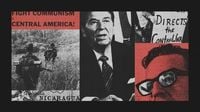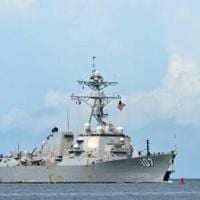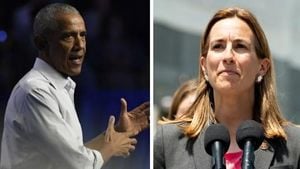In a dramatic turn reminiscent of Cold War geopolitics, President Donald Trump’s administration has revived a hardline approach to Latin America, sparking fierce debate at home and abroad. The so-called “Donroe Doctrine”—a play on the historic Monroe Doctrine—marks a return to aggressive U.S. interventionism in the region, with the stated goal of protecting American interests and countering foreign influence. Yet, as the U.S. Navy patrols Venezuelan waters, CIA teams reportedly operate inside the country, and economic carrots and sticks are deployed from Buenos Aires to Bogotá, the echoes of history and the risk of backlash are impossible to ignore.
Historically, the Monroe Doctrine, first articulated in 1823, was about keeping European powers out of the Western Hemisphere. Over time, this policy faded as globalization made rigid spheres of influence seem outdated. Now, according to Moneyball Economics, President Trump has “brought back his own version of the Monroe Doctrine,” but the threat is no longer Europe—it’s the growing presence of China and other rivals in South America.
The Trump administration’s actions have been nothing short of forceful. Off the coast of Venezuela, the U.S. Navy has attacked 13 ships, resulting in 57 deaths, with operations ongoing as of late October 2025. In August, the U.S. government put a $50 million bounty on Venezuelan President Nicolás Maduro, escalating pressure on a regime seen as deeply hostile to Washington. According to Moneyball Economics, “We have publicly talked about sending in CIA strike teams into Venezuela itself to go after the cartels. Look, this is nothing more or less than regime change while publicly, the assertion is that it’s a narco-terrorist state, a crypto-terrorist state, whatever you want to call it.”
Venezuela, with its vast oil reserves—among the world’s largest—has long been a focal point for U.S. interests. American sanctions have kept much of this oil offline, but the Trump administration is betting that regime change will open the door for American companies to re-enter the market. “Once we get regime change in Venezuela... you’re going to start seeing deals being cut with Chevron and Exxon to drill for this oil,” Moneyball Economics predicts.
But the U.S. isn’t relying solely on military might. In Argentina, the administration took a different tack—lending $40 billion to the country and, as Moneyball Economics puts it, “basically bought their election last week.” The newly elected leader, Javier Milei, is pro-U.S., pro-capitalism, and seen as a key ally in the region. “We love him so much, we lent $40 billion and basically bought their election last week. It worked. So now Argentina is beholden to the U.S. and hopefully there will be traction and it will lead to more and more partnership,” the analysis continues.
This two-pronged strategy—pressure in the north, partnership in the south—has created two poles of U.S. influence: Venezuela and Colombia in the north, Argentina and Chile in the south. Colombia, labeled a “narco-terrorist state” by the Trump administration, is also under pressure, with tariffs and sanctions aimed at leftist President Gustavo Petro. In Chile, the U.S. is working to improve ties, mindful of the country’s critical copper reserves, which are essential for the booming electric vehicle industry. “Why do we care? Well, world’s largest copper source is in Chile and electric vehicles depend on copper even more,” Moneyball Economics notes.
Underlying these moves is a broader contest with China. As reported by Moneyball Economics, Chinese investments in South America have soared 35-fold in the past two decades, making China the largest trading partner for major countries like Chile, Peru, Bolivia, Brazil, and Argentina. The U.S. is now scrambling to counter China’s economic and political influence, pouring money and diplomatic energy into the region. Ports and infrastructure, often funded by Chinese loans, are seen as potential intelligence assets and levers of power.
Yet, this new assertiveness has dredged up bitter memories across Latin America. As The New York Times and The Washington Post remind readers, the U.S. has a long and checkered history of intervention in the region—from Teddy Roosevelt’s Panama Canal gambit to Ronald Reagan’s support for Nicaraguan rebels, and CIA-backed coups that toppled democratically elected leaders in Guatemala, Brazil, and Chile. “America has a long record of fomenting regime change in Latin America,” writes Max Boot at The Washington Post. “That approach has seldom worked out well and created deep-rooted resentment in the region, yet Trump wants to reprise this ignominious history.”
Latin American leaders have not been shy about their displeasure. Colombian interior minister Armando Benedetti declared, “Gringos, go home,” as reported by Mother Jones. Brazilian presidential advisor Celso Amorim warned that American actions could “inflame South America and lead to radicalization of politics on the whole continent.” The specter of anti-Yanqui sentiment looms large, with commentators warning that U.S. actions could backfire, further entrenching adversaries and fueling instability.
Inside the U.S., criticism has come from both sides of the aisle. Democratic Senator Mark Kelly, in an ABC News interview, questioned the wisdom of moving a naval battle group to the Caribbean: “You don’t move a battle group all the way from where it was to the Caribbean unless you’re planning on either to intimidate the country—which is rather intimidating—or you’re going to start conducting combat operations in Venezuela.”
Even as Trump denounced generations of U.S. interventionism in the Middle East during a speech in Riyadh in May 2025, his administration’s approach to Latin America has been starkly different. “I think definitely the goal of the Trump administration is to shape Latin American politics in the form of a MAGA agenda,” said Renata Segura of the International Crisis Group, as quoted by Fox 28 Spokane. Yet, as Segura points out, the Trump movement is also skeptical of deep foreign entanglements—leaving open questions about how far the administration is willing to go.
The stakes are high. The Trump administration sees cheap energy as the linchpin of a U.S. manufacturing renaissance and a tool to weaken adversaries like Russia and Iran. At the same time, the risk of unintended consequences—regional instability, mass migration, and a new wave of anti-American sentiment—remains ever-present.
As of late October 2025, the crisis appears to be at a tipping point. According to Geoff Ramsey of the Atlantic Council, the U.S. faces a critical decision: “whether to escalate to military strikes inside Venezuela, or whether to declare victory and move on.” With history as a guide, and the region’s future hanging in the balance, the world is watching to see which path Washington will choose.
The Trump administration’s gamble in Latin America has revived old debates and opened new fronts, with consequences that may reverberate for years to come.





